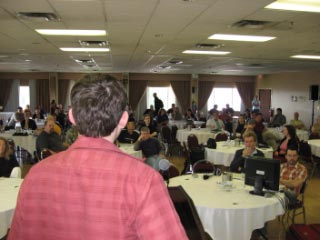June was a month of wall to wall conferences. And those conferences brought Gini Dietrich, Martin Waxman and me together in two cities – Austin and Ottawa – and pulled us to opposite ends of the continent.
 So, you spend all that money and time to attend a conference. And now you’re sitting in a presentation and you’re deciding whether you made the right decision. What makes it worthwhile?
So, you spend all that money and time to attend a conference. And now you’re sitting in a presentation and you’re deciding whether you made the right decision. What makes it worthwhile?
Gini applies the Chile Con Queso Test. She loves chile con quesos. And she judges a restaurant by their quality. If they’re great, she’ll keep going back for more. Gini’s Chile Con Queso Test for conference presentations? Does the presenter provide her with at least one idea for a blog post? “If I can go into your session and come away with a blog post idea, I’m going to think you’re the best speaker on earth,” says Gini. On the other hand, “If I can’t get at least one idea to create content around, I’m not going to think you’re a great speaker.”
If you’re a speaker, how can you deliver the goods for your audience? I saw Lee LeFever talk about this at the recent Fireworks Factory organized by Darren Barefoot and Julie Szabo. Lee, who is best known for the explainer videos he has produced through his company, Common Craft, says that you must start from a position of empathy for the audience. Focus on what we care about, not what you want to present. Frame your topic in terms to which we relate. Suggest a commonly experienced problem to which we all relate. You’ll know you’ve done this is you see our heads nodding. Once you’ve established the shared space, focus on “why.” Why does this matter? Why will you approach it in this way. And then, and only then, move on to the “how.” How do I do this. Think about the presentations you’ve seen recently. How many of them failed because the presenter plunged directly into the “how” section, providing minute detail of what they did, while you were still stuck at, “Why do I care about this?”
Martin calls this the importance of appealing to the audience’s emotional senses. He points out that this often can be achieved through story telling, in which a motive is established and listeners are drawn into identifying with the subjects and storyline. Gini agrees with the power of this approach, pointing to a 52N (five minutes to engage, a variant on Ignite) presentation delivered by Abbie Fink at the recent PRSA Counselors Academy Conference in Austin. Abbie’s presentation consisted of reading a letter to her recently deceased family dog. At the end, she left many in the room in tears and everyone considering the nature of relationships. A story that appealed to our emotions. That appealed to the pet lover in all of us. That didn’t explain the why, but relied throughout on it. (Pity the poor presenter who followed Abbie – Martin Waxman!)
I attended a presentation recently by a speaker who gave me not just one good takeaway, but nine. Nine takeaways in an hour long presentation. And that speaker was … Gini Dietrich! Perhaps because Gini listened for takeaways in other speakers, she deliberately packages takeaways in her presentations. “When I write presentations, I write them long form. But as I do it, I write sound bites that I know people can tweet. You have to think about the key takeaways. Is someone going to get enough to pass the Chile Con Queso Test? And are they going to be able to tweet about it?” If you achieve these three objectives, people will come away with something to think about over the long term as well as content that will prompt immediate tweets and conversation.
Finally, there’s one huge no-no for conference presenters. What makes the audience groan and flee the room in droves? Martin calls it the “You can’t judge a presentation by its cover” problem.” You decide to attend a presentation on the basis of the description in the program only to hear the speaker lead off with the statement, “I’m going to talk about something different from the advertised topic…” Sadly, that’s not uncommon at conferences. Not just the small regional conferences, but even larger conferences. The kindest interpretation I can put on this it that because of the long lead time between the time that the conference topics were set and the actual presentation, the speaker decided that the topic was outdated and decided to offer more up to date thinking. The unkind interpretation is that the speaker just said yes to the organizers’ invitation and then realized that he didn’t really have anything worthwhile to say about the topic. Either way, it can be a real let down if you showed up keen to learn and discuss the advertised topic.
Gini sums it up: “We’re all busy. We all want to find value in the things that we are attending. We’re spending money to attend these things. And if we can’t get something out of it to bring back to our careers or organizations, then it’s not worth the time.”
This post was originally published on the Inside PR podcast blog.







